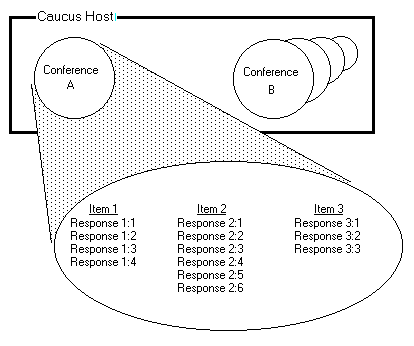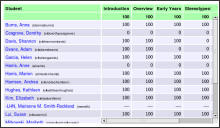


- What's it good for?
- How do people use it day-to-day?
- What is the architecture?
- Will it meet my needs?
Caucus is about conversation and education, and where they meet. It is not about real-time chat or video conferencing. It is about convenience: learners use it at any time, from any place. It's about keeping a history of lessons and conversations that are at once easy to use, to keep up with, and yet easy to structure and find things in. Best classes, on the web
Think of the best class you ever took (or taught!). It had a room, desks, books, a teacher, homework, and so on. But what made it special? Probably the interaction -- the conversations, questions, even arguments -- with the teacher and with the other students. Now put that class on the web. The conversations are saved, structured, secure, and searchable. And easy to keep up with -- each student "attends" at their own convenience and schedule. A Caucus class has most of the attributes of a live class...
- A "room", with a class list. Only members can attend, and teachers and assistants have special privileges.
- Assignments, with scheduled start (visible) and stop dates, and due dates.
- Lessons and content -- anything that can be put on (or linked from) the web.
- A gradebook. Students can always (and only) see their own grades.
- Quizzes -- with automatic scoring.
- Conversations! Highly structured, yet easy to follow and participate in.
- Detailed information about which students read what, said what, and did what.
- For each student, tracks what they've already read, what's new to them, what key points they want to remember and return to.
- Conversations are not limited by space and time. Many conversations can go on in parallel, for days or weeks. Talkative students can't dominate; quiet students participate at their own comfort level.
Let's stop here for a moment and get real. Obviously no online class is going to have the immediacy of a live, in-person class. This is especially true for "asynchronous" classes, where everyone participates at different times. On top of that, when you're having a conversation, it's a lot easier to speak than it is to type! But, if you're already
- Running a class where the members rarely meet face-to-face, or
- Looking for a way to extend your existing 'live' class onto the web
Of course, Caucus can be used anywhere that people need to coordinate their conversations. It's especially powerful for distributed groups of people that need to share information, track the history of an issue, or reach consensus. (Ever try to have a conversation among 3 or more people via email? And then find something you said a month ago? Or bring another person up to speed, later? It can't be done.)
How do people use Caucus day-to-day?
Even Caucus' navigation is centered around conversations. Most of the time, you'll just click on a

- At the top is the Caucus Center. The Center lists all of the classes you attend, with a short summary of (and link to) the new activity in each.
- Each class has a list of "items"; an item is a discussion or a lesson or any web object. Each item optionally has a single thread of discussion "responses". (If 'threading' is a hot topic for you, see our approach.)
- To repeat, most of the time you'll just click on read all new. Caucus will automatically take you through the new items and responses. In each discussion, you can add your own response(s) with a WYSWYG editor. (You can also link to others' responses, store responses in your private notebook, attach files, link to your to-do list, and much more.)
- The rest of the time, you're
coming back to find something, or to add something new.
In either case, you can navigate there via any of:
- The class title, and/or the individual item titles.
- The search button.
- The links in your private notebook, or your to-do list.
- The item or response author.
- Even your browser bookmarks.
- If you are an instructor, you have many
more responsibilities, of course.
But Caucus still makes it easy for you to:
- Create, archive, delete, or copy classes.
- Post new material (and "hide" it until you're ready for everyone else to see it)
- Moderate, prompt, edit, or even rearrange discussions.
- Post assignments.
- Calculate and post grades.
- Evaluate students' participation in discussions.
- Email all your students with specific announcements, or send them automatic email notifications of new material.


